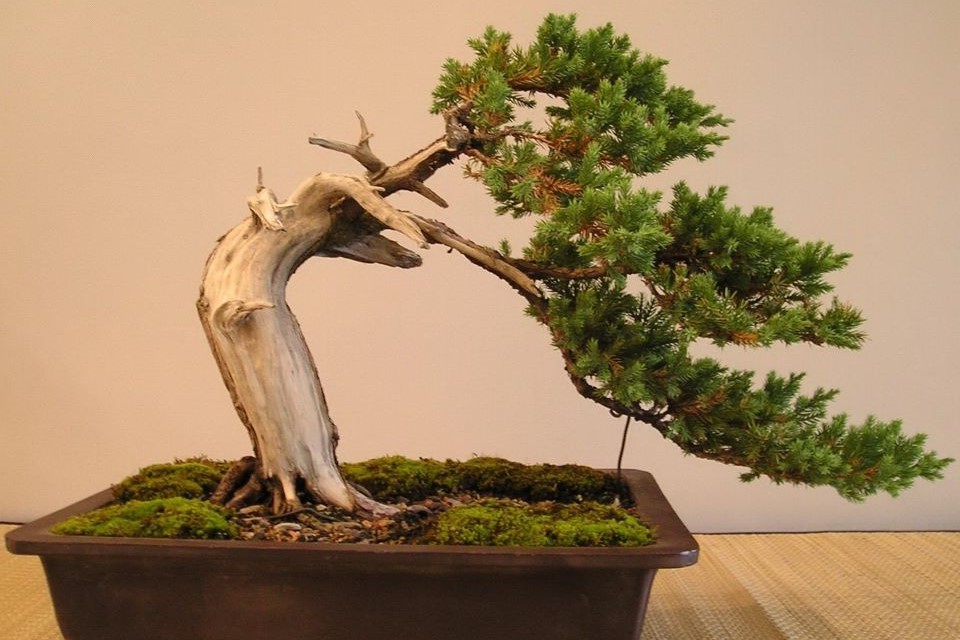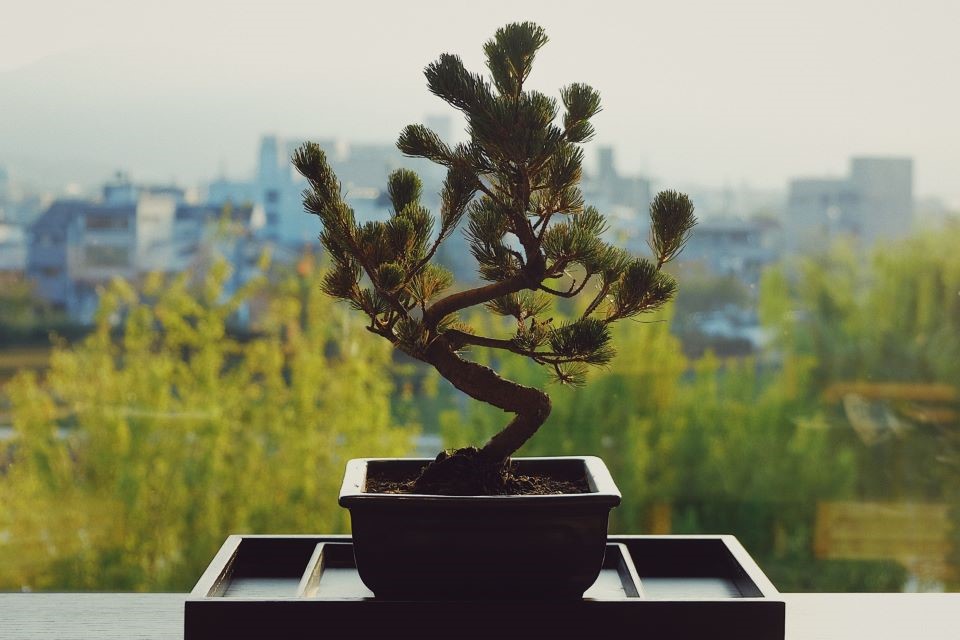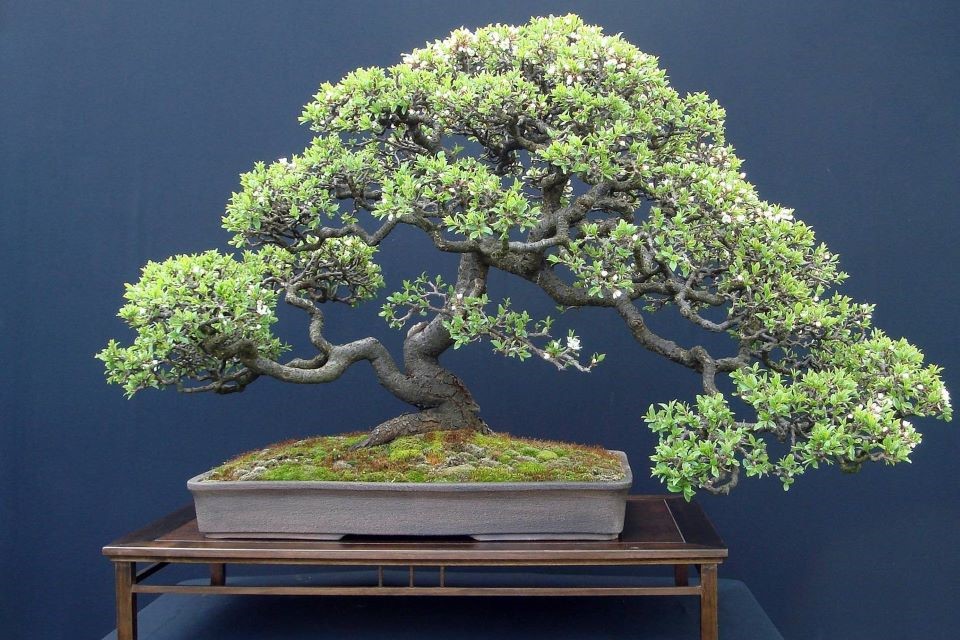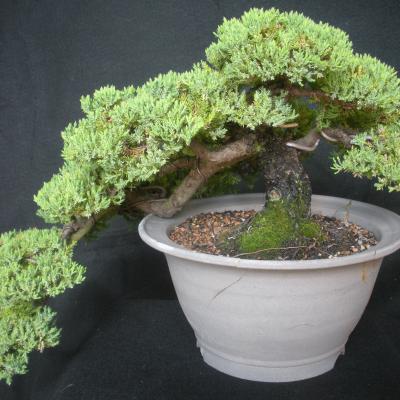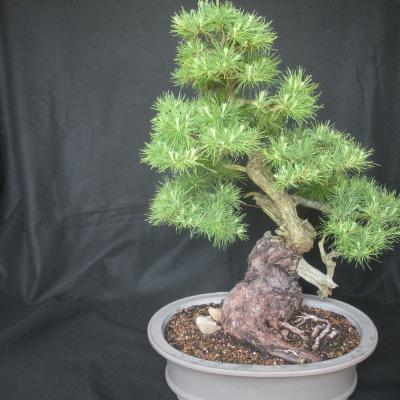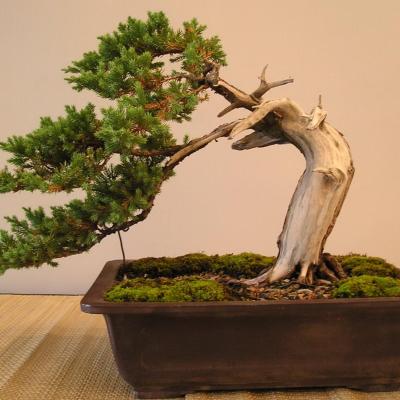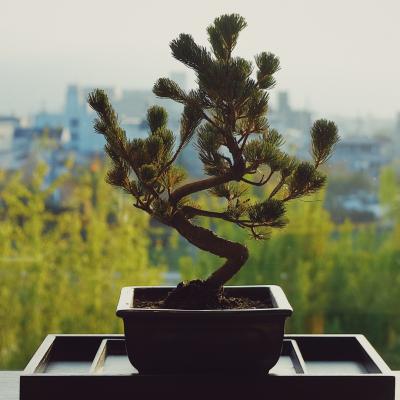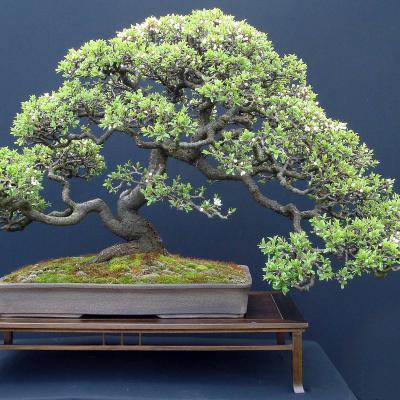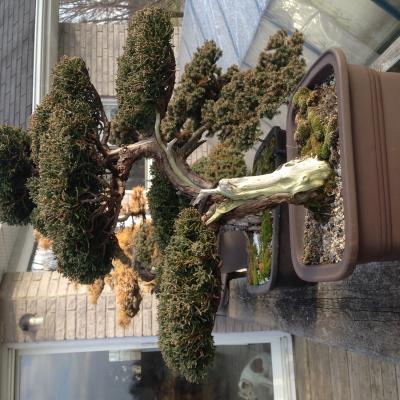BONSAI CARE
2018-03-22
Basic Care of Bonsai
WATERING
More bonsai are lost due to improper watering than from all other causes combined. The length of time between watering can vary quite a bit depending on conditions such as humidify, soil moisture retention, weather conditions, and size of pot. Bonsai usually need to be watered every day or two. The best time to water is early in the day or late in the afternoon at the same time every day. A through watering is accomplished when excess water runs out of the drainage holes in the bottom of the pot, BUT ... too much water can be just as bad as too little water. In general the soil should be moist, not soaking wet, and not dry
FERTILIZING
Feedings vary from plant to plant (such as flowering plants have different requirements than the junipers). A water-soluble fertilizer is usually applied every 2 to 4 weeks during the growing season, in a half-strength solution. Miracle-Gro or Miracid are commonly used, but check label directions for your tree. DO NOT FEED right after re-potting (wait for 3-4 weeks). Don't feed if the tree is in a sicken condition. Pre-moisten the plant soil first. Never fertilizer a very dry bonsai.
REPOTTING
A bonsai must periodically be re-potted to supply a pot-bound root system with fresh soil. It is also necessary to keep the root system in balance with the top growth. Most require re-potting every two or three years. This depends on the growth of the tree and also on the size of the pot. This should be done in the early spring. Do not fertilize for 3-4 weeks after re-potting. Do not let the roots go dry while re-potting. Water well when finished.
INSECTS & DISEASE
A bonsai is nothing more than a miniature version of a normal plant, therefore it can be treated with commonly found insecticides and fungicides according to directions on the package. Insects such as aphids, spider mites, scale, and root aphids are a common problem corrected by sprays, soapy rinse, or a systemic.
TRIMMING PRUNING AND TRAINING
Trimming and pruning are the means by which a bonsai is kept miniature. This involves the systematic removal of vigorous growth in the spring. It is important however, to understand that for the health of the tree one should never remove all the new growth at one time. The roots are trimmed and so is the foliage on the plant. The tree is wired to assist in getting branches to grow in a specific position and to enhance the look of the tree. The wire is removed after 6 months. Usually the branch should then stay in that position on it's own. Wire should be carefully cut from the branches. Do not unwind wires as this could break the branch. Trim branches to expose the trunk and to shape the tree into the look you want. Two goals in bonsai are to make young trees look older by thickening the trunk and the positioning of the branches, and to find enjoyment in Nature.
INDOOR BONSAI
There are many varieties of plants that do well as an indoor bonsai such as ficus, aralia, azalea norfolk pine, serissa, gardenia, or boxwood. Note that these are all woody-stemmed plants and can have their limbs wired to direct the growth. Tropical and subtropical varieties can not tolerate tempers below 40 - 50 degrees F. These plants can be left outside when the temperatures stay above this. Light inside the house should be by filtered sunlight from an east, south, or west window. Grow lights 12 hours per day work well. Outside in summer place in partial shade.
OUTDOOR BONSAI
There is a wide choice of trees for outside bonsai. The winter dormant period is essential to the general good health of a bonsai. In northern climates winter protection from freeze-drying winds is necessary. Trees should be kept in an unheated area. An unheated garage, shed, breezeway, or cold frame can provide this. Check with your bonsai club for other ways. Check the root system for moisture and water as necessary while in winter storage. Unless the root ball is frozen they will need to be watered every week or so. In the summer water more often as weather conditions demand. Never let the tree go dry but do not keep it soaked either. Some of the trees suitable for outdoor bonsai are, junipers, maples, elms, pines, ginkgo, hawthorn, and flowering crab apple.
CREDITS
This introduction to the art of bonsai was written by Connie Todd and has been provided through the courtesy of The Iowa Bonsai Association, a non-profit organization devoted to the art and study of bonsai. The Iowa Bonsai Association provides its members with programs and workshops relating to bonsai and the horticultural species adaptable to this art. The illustrations are by Norman Haddrick, a bonsai grower and artist living in Canada. The Iowa Bonsai Association may be contacted: E-mail:
WHAT IS BONSAI
2018-03-22
Bonsai (pronounced bone-sigh) is an ancient oriental horticultural art form. The word Bonsai literally means, in both Chinese and in the Japanese language, tree-in- a-pot. Originally developed in the Orient almost 2000 years ago, today the sublime art of bonsai is practised throughout the world. Shape-harmony-proportion-scale are all weighed carefully as art, and the human hand combines this in a common cause with nature.
A tree planted in a small pot is not a bonsai until it has been pruned, shaped, and trained into the desired shape. Bonsai are kept small by careful control of the plant's growing conditions. Only branches important to the bonsai's overall design are allowed to remain and unwanted growth is pruned away. Roots are confined to a pot and are periodically clipped. Bonsai may have a stylized or an exaggerated form ... but, as found in nature. The appearance of old age of a plant is much prized and bonsai may live to be hundreds of years old. The living bonsai will change from season to season and from year to year requiring pruning and training throughout it's lifetime ... and as time goes on it will become more and more beautiful. It is impossible to write a simple set of care rules. Every species of plant has it's own special needs. Each location and environment is different too, and have to be considered. Therefore it is important, when starting in bonsai, to read all you can on the art. Take advantage of your local bonsai club.
TRIMMING AND PRUNING
2018-03-22
Trimming and Pruning are one of the means by which a bonsai is kept miniature. This involves the systematic removal of vigorous growth in the spring. The first step in how to prune a bonsai tree is that you always want to make sure you are pruning the tree in the appropriate season. Although there are some types of trees that can be pruned and trained throughout the year, many trees must be worked with during a specific time. Otherwise, you will find that you run into all types of problems. Although you can conduct a lot of research on-line, if you are unsure of the right time for your particular type of tree, locate a bonsai specialist or nursery in your area that can provide you with guidance. Just remember that whatever rule applies to the full-sized tree will also apply to your miniature tree.
The most important aspect of pruning a bonsai tree is you need to provide your tree with adequate time to recover after going through a severe pruning. With proper care and scheduled pruning, your tree will grow and remain healthy for years. In fact, many bonsai trees have been passed down from generation to generation. When pruning, you want to focus the majority of your attention on the trunk, which will add to the illusion of mature size and age, more so than any other feature on the tree.
Next on how to prune a bonsai tree, be sure you leave extra branches on any weak area of the trunk to help promote growth in that particular area. Then, any problem branches should be removed right away. Problem branches would be considered those that cross each other, growing back sharply toward the trunk or from the underside of the main branches. The challenge when you experience this is that you end up with a cluttered or messy appearance that takes away from the artistic line of the tree.
Another important aspect of how to prune a bonsai tree is that whatever you do above ground level will also affect what happens to the tree below the ground and vice versa. In other words, if you prune the branches and leaves heavily with no cutting back of the root system, then the following season, the bonsai tree could have an incredible burst of growth as it tries to fix the imbalance. With bonsai, you can allow the root system to be ahead of the foliage and branches but by no more than 30%. If you find that you need more root growth, you can move the bonsai tree to a larger container to encourage the roots to spread.
As you can see, how to prune your bonsai tree is not a complicated subject but it is a necessary one. You have to prune your tree as a means of maintaining the correct shape of the tree, while encouraging new growth. What you will discover is that some trees respond naturally and very well to pruning while others have a hard time recovering. Again, the key is to prune only in the right season for the type of tree you have. With evergreen coniferous bonsai trees, you can use a method known as “finger pruning”, which means to pinch back new growth that does not have the general shape of the bonsai or growth at the top of the tree. This method will encourage fuller foliage and a better looking bonsai.
When it comes to how to prune a bonsai tree for deciduous, which would include tree such as the Chinese Elm and Maples, you would use the tip of sharp scissors for pruning. For this, when you trim outward, you want to trim back the shoots but just after the next series of leaves. Finally, leaf pruning is used for both tropical and deciduous plants. This helps reduce the size of the leaves, get rid of unsightly leaves, and encourage growth by creating two growing seasons in one. Again, when it comes to how to prune a bonsai, the process is not difficult as long as you are careful!
Wiring/Training:
Wiring accompanies trimming and pruning are the means by which a bonsai is grown to the desired shape. The tree is wired to assist in getting branches to grow in a specific position and to enhance the look of the tree. Depending on the tree and its growth rate the wire is removed after 6 – 18 months and before your tree grows in to the wire. Usually the branch should then stay in that position on it's own, if not you will have to rewire to the desired shape. Wire should be carefully cut from the branches. Do not unwind wires as this could break the branch. Trim branches to expose the trunk and to shape the tree into the look you want. Two goals in bonsai are to make young trees look older by thickening the trunk and the positioning of the branches, and to find enjoyment in Nature.
2018-03-22
One of the favourite bonsai is the ficus tree. A miniature version of the tropical Banyan tree, the ficus is exotic and rewarding. Therefore, it is a good species and to help you get started with your bonsai. Remember, the ficus is ideally suited for indoor bonsai. You will discover a number of different varieties, each with small leaves and slow growth habits. Some of the specific species you might consider growing include the narrow-leaf ficus, weeping ficus, and the dwarf ficus, all fine choices.
The first thing to remember when it comes to ficus bonsai care is that this tree needs to be kept indoors all year-long, although an occasional trip outdoors for fresh air and sunshine is acceptable. As with most bonsai trees, the ficus tree should dry out between watering. To test the soil, simply stick your finger down about an inch to see if it feels wet or dry. The key with ficus bonsai care is never allow the tree to go completely dry for any extended time. To water your tree, soak it and/or the container it sits in, in water for about 10 minutes. Then, allow the soil to drain so no more water leaks from the bottom.
Re-potting is also important for ficus bonsai care. The recommendation is to repot the tree every two years. Now, keep in mind that while the ficus typically grows slow, if you notice the tree is having a growth spurt, completely taking over its container within the first year, do no wait to repot, go ahead and do the re-potting in the first year. The best time to repot a ficus bonsai is during early spring months. Once the tree has been placed in its new container (larger of course), be sure you water it thoroughly, using the same process as described above. Then, you want to keep your ficus bonsai in a shady place for two to three weeks, allowing the new root system to take hold. With this, you will enjoy a much healthier and stronger plant that when it comes time to trim and prune, it will handle the processes much better.
Finally, ficus bonsai care means understanding your tree during the cold, winter months. This particular tree should always be kept indoors, especially in the winter. Even then, make sure you keep them on display in a sunny area that never goes below 60 to 65 degrees. Now, you may notice some minor leaf drop if the temperatures are too cool for the tree or if the ficus is getting too much of a draft. In this case, you can simply choose a different location, again in the sun but warmer and without the draft. With ficus bonsai care, it is not difficult, but consistency and understanding the ficus are important. As you begin to trim back the tree during its growing season and using wire to create the shape you have chosen and the one that works best with this species, you will begin to notice things changing from a simple tree in a container to an actual bonsai. Chances are you will be so proud of your accomplishments, you will be eager to try another ficus bonsai or perhaps one of the many other species.
